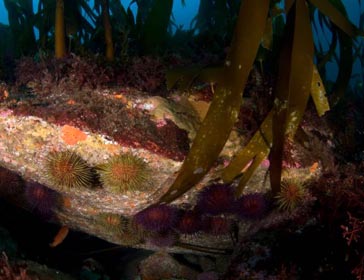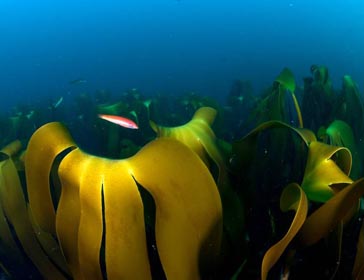Feature: Underwater forests
 Kelp are large brown algae (1) that form a habitat very similar to a terrestrial forest. In Europe, their place is taken by other Laminaria forests that can be found in both the Atlantic and the Mediterranean. The most common species to be found in these ecosystems are Saccorhiza and Laminaria.
Kelp are large brown algae (1) that form a habitat very similar to a terrestrial forest. In Europe, their place is taken by other Laminaria forests that can be found in both the Atlantic and the Mediterranean. The most common species to be found in these ecosystems are Saccorhiza and Laminaria.
Despite their great biological importance, kelp forests have not been recognised by European legislation as a priority habitat for protection. Oceana will be working to ensure that in Europe, as well as internationally, they are regarded as protected ecosystems.
The largest kelp in existence in the world is the giant kelp (Macrocystis pyrifera) which can reach heights of 30 metres and has a bipolar distribution: along the Pacific coasts of America between Alaska and Baja California (Mexico), off the southern coasts of Chile and Argentina, in the waters of New Zealand and Australia, and off South Africa. It can be found at depths of up to 60 metres when sea conditions allow light to penetrate. It prefers warm waters although it can also be found in waters quite close to the poles, so long as the temperature does not drop below 5ºC, which would destroy its gametophytes (the sexual organs of kelp).
A “pregnancy” of between 12 and 14 months
Kelp begins life as spores which can give rise to either male or female gametophytes. The female kelp gametophytes produce “eggs” which must be fertilised by sperm from the males. For this purpose, the female gametophytes are equipped with pheromones to attract the males and fertilise the eggs, which subsequently develop as sporophytes – plants from which trillions of spores will emerge, of which only a tiny percentage will eventually create a plant. And of every 100,000 new young plants, barely one of them will reach adulthood.
As if it were a pregnancy, the life cycle of the kelp needs between 12 and 14 months to go full circle. The majority develop and die within just 6-9 months in a continuous process of fertilisation, growth (at an amazing rate of up to 50-60 centimetres per day) and death.
As well as giant kelp, other large “marine trees” or kelp species can be found, including:
“feather boa” kelp (Egregia menziesii)
ribbon kelp (Egregia laevigata)
elkhorn kelp (Pelagophycus porra)
and southern sea palm (Eisenia arborea), amongst others
Sea urchins: their number one enemy
 Just as if they were terrestrial forests, laminaria or kelp forests function like large trees, enabling hundreds of animals and plants to live amongst their “canopies”, “branches” and “root” system. (2)
Just as if they were terrestrial forests, laminaria or kelp forests function like large trees, enabling hundreds of animals and plants to live amongst their “canopies”, “branches” and “root” system. (2)
A great diversity of species find their ideal habitat in these ecosystems, such as the Garibaldi (Hypsypops rubicundus), the blacksmith (Chromis punctipinnis), kelp bass (Paralabrax clathratus), island kelpfish (Alloclinus holderi), and the señorita (Oxyjulis californica), etc. There are also numerous other species accommodated here, such as crustaceans and polychaete worms.
It is also not unusual to spot between the stems of these “trees” species such as the blue shark (Prionace glauca) or cetaceans such as the Pacific whitesided dolphin (Lagenorhynchus obliquidens).
The main enemies of kelp are sea urchins which feed on their shoots and leaves and can demolish huge swathes of these underwater forests. But fortunately starfish and ocean catfish eat sea urchins, controlling their populations and preventing them from destroying the kelp ecosystem. Sea otters (Enhydra lutris) also feed on sea urchins and abalone (Haliotis spp.), which are easy to find in these intricate forests.
The overexploitation of sea urchin-eating species could lead to the collapse of kelp forests by triggering the over-population of echinoderms such as the red sea urchin (Strongylocentrotus franciscanus) and the purple sea urchin(Strongylocentrotus purpuratus).
Laminaria, the kelp of Europe
In Europe, the role of kelp is occupied by forests of laminaria (Laminaria algae) which can be found in both the Atlantic and the Mediterranean. The most common species to be found in these ecosystems are Saccorhiza and Laminaria.
Although European kelp do not achieve the extraordinary dimensions of their Pacific relatives, some species can reach considerable heights:
This is the case of cuvie (Laminaria hyperborea) in the North Atlantic, which can exceed five metres in height, and A kelp or kombu (Laminaria ochroleuca), which reaches more than four metres in certain areas of the Mediterranean, such as the Alboran Sea and the waters of the Strait of Messina off Sicily.
There is also a species endemic to the Mediterranean, Laminaria rodriguezi, which can attach itself to hard substrates at depths of up to 150 metres. It is found in Spain (Catalonia, the Balearic Islands and the Valencian Community), Italy (especially in the Tyrrhenian Sea), France (mainly around Corsica), between Croatia and Montenegro, and off North Africa.
 In the Atlantic area, the most common species are dabberlocks (Alaria esculenta), sugar kelp (Laminaria saccharina), oarweed (Laminaria digitata) and others such as furbelows (Saccorhiza polyschides), or the previously mentioned cuvie (Laminaria hyperborea), which can be found from Norway and Galicia to the Strait of Gibraltar, while others, such as Saccorhyza polyschides reach as far as the Mediterranean, although they are absent in the North Sea and the Baltic.
In the Atlantic area, the most common species are dabberlocks (Alaria esculenta), sugar kelp (Laminaria saccharina), oarweed (Laminaria digitata) and others such as furbelows (Saccorhiza polyschides), or the previously mentioned cuvie (Laminaria hyperborea), which can be found from Norway and Galicia to the Strait of Gibraltar, while others, such as Saccorhyza polyschides reach as far as the Mediterranean, although they are absent in the North Sea and the Baltic.
Many of these Laminaria species are frequently found off the Cantabrian coasts (the easternmost point for Saccorhiza polyschides and Laminaria ochroleuca is Elantxobe) and Galicia (where Laminaria saccharina and L. hyperborea can also be found).
Industrial uses of kelp
As well as its significant environmental value, many species of kelp are tremendously important to industries as varied as food, pharmaceuticals, paint, construction and cosmetics.
Apart from the direct consumption of the plant or its use as a fertiliser, kelp produces a substance (polysaccharide) known as an alginate which is widely used as an emulsifier in the following products:
food (ice-creams, sauces, beers, yoghurts…)
personal hygiene(toothpaste, shampoo, soap…)
medicinal (pills)
industrial (dyes, paints, soldering…)
Invasive kelp
Algae farming and the ballast waters of merchant vessels have introduced certain varieties of kelp into alien ecosystems, resulting in serious problems which could endanger indigenous species and even affect mollusc populations.
This is the case of wakame or Japanese seaweed (Undaria pinnatifida); originally from the North-East Pacific, it is regarded as one of the most threatening species due to its extensive proliferation outside its own ecosystem, currently occupying huge areas of the East and South Pacific, the North and South Atlantic, including the Mediterranean, and the Baltic.
During the expedition from the Pacific to the Mediterranean, Oceana will also be researching and documenting other important ecosystems created by brown algae, such as the Sargasso Sea and certain sea beds of Cystoseira spp.
1. Despite the fact that they can be green, kelp falls within the definition of “brown algae”, as these algae contain chlorophyll A and C and apart from their green pigment also contain other pigments that allow them to make more efficient use of sunlight for photosynthesis at great depths. This pigment, known as fucoxanthin, occasionally gives the kelp a brown or golden appearance which allows the reflection of yellow light.
2. Algae do not have roots, stalks or leaves as we know them in trees and other plants. Instead, they use a system of anchoring themselves in the substrate known as haptera or rhizoids which serve to anchor the thallus, which can divide itself in certain species into a stipe, or stem, and fronds, or leaves.
An important laminaria zone that has very good forests is the Isle of Helgoland in the German Bight in the North Sea. Both Laminaria digitata and Laminaria hyperborea can be found here.


